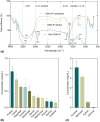Bioprospecting microwave-alkaline hydrolysate cocktail of defatted soybean meal and jackfruit peel biomass as carrier additive of molasses-alginate-bead biofertilizer
- PMID: 34996897
- PMCID: PMC8742054
- DOI: 10.1038/s41598-021-02170-w
Bioprospecting microwave-alkaline hydrolysate cocktail of defatted soybean meal and jackfruit peel biomass as carrier additive of molasses-alginate-bead biofertilizer
Abstract
The extraction of soluble hydrolysate protein and sugar from a biomass cocktail of defatted soybean meal (DSM) and jackfruit peel (JP) was examined using microwave-alkaline hydrolysis by varying the NaOH concentrations (0.04-0.11 M) and residence times (2-11 min). Based on the central composite design, the optimized parameters were achieved at 0.084 M NaOH concentration (100 mL), for 8.7 min at 300 W microwave power level to obtain the highest protein (5.31 mg/mL) and sugar concentrations (8.07 mg/mL) with > 75% recovery. Both raw and detoxified hydrolysate (using activated carbon) were correspondingly biocompatible with Enterobacter hormaechei strain 40a (P > 0.05) resulting in maximal cell counts of > 10 log CFU/mL. The optimized hydrolysate was prepared as an additive in molasses-alginate bead encapsulation of strain 40a. Further evaluation on phosphate and potassium solubilization performance of the encapsulated strain 40a exhibited comparable results with those of free cell counterpart (P > 0.05). The DSM-JP hydrolysate cocktail holds potential as a carrier additive of encapsulated-cell bead biofertilizers in order to sustain bacterial cell quality and consequently improve crop growth and productivity.
© 2022. The Author(s).
Conflict of interest statement
The authors declare no competing interests.
Figures






Similar articles
-
Okra Growth, Yield and Rhizosphere Microbiome Responses to the Encapsulated Bioinoculant Application under Reduced Fertilization Regime.Biology (Basel). 2022 Jul 25;11(8):1107. doi: 10.3390/biology11081107. Biology (Basel). 2022. PMID: 35892963 Free PMC article.
-
Physicochemical properties of soy protein hydrolysate and its formulation and stability with encapsulated probiotic under in vitro gastrointestinal environment.J Food Sci. 2020 Oct;85(10):3543-3551. doi: 10.1111/1750-3841.15399. Epub 2020 Aug 31. J Food Sci. 2020. PMID: 32869300
-
Improvement of Omega-3 Docosahexaenoic Acid Production by Marine Dinoflagellate Crypthecodinium cohnii Using Rapeseed Meal Hydrolysate and Waste Molasses as Feedstock.PLoS One. 2015 May 5;10(5):e0125368. doi: 10.1371/journal.pone.0125368. eCollection 2015. PLoS One. 2015. PMID: 25942565 Free PMC article.
-
Lipid Production of Heterotrophic Chlorella sp. from Hydrolysate Mixtures of Lipid-Extracted Microalgal Biomass Residues and Molasses.Appl Biochem Biotechnol. 2015 Oct;177(3):662-74. doi: 10.1007/s12010-015-1770-4. Epub 2015 Aug 4. Appl Biochem Biotechnol. 2015. PMID: 26234438
-
Production of nutty-like flavour from soybean protein isolate hydrolysate pretreated or assisted by microwave irradiation: impact of encapsulation on nutty flavour quality.J Food Sci Technol. 2022 May;59(5):1958-1967. doi: 10.1007/s13197-021-05211-4. Epub 2021 Jul 22. J Food Sci Technol. 2022. PMID: 35531421 Free PMC article.
Cited by
-
Effect of Microwave Pretreatment on the Antioxidant Activity and Stability of Enzymatic Products from Milk Protein.Foods. 2022 Jun 15;11(12):1759. doi: 10.3390/foods11121759. Foods. 2022. PMID: 35741957 Free PMC article.
-
Okra Growth, Yield and Rhizosphere Microbiome Responses to the Encapsulated Bioinoculant Application under Reduced Fertilization Regime.Biology (Basel). 2022 Jul 25;11(8):1107. doi: 10.3390/biology11081107. Biology (Basel). 2022. PMID: 35892963 Free PMC article.
References
-
- Tan KZ, et al. Isolation and characterization of rhizobia and plant growth-promoting rhizobacteria and their effects on growth of rice seedlings. Am. J. Agric. Biol. Sci. 2014;9:342–360.
-
- Mnasri N, et al. Efficacy of some rhizospheric and endophytic bacteria in vitro and as seed coating for the control of Fusarium culmorum infecting durum wheat in Tunisia. Eur. J. Plant Pathol. 2017;147:501–515.
Publication types
Grants and funding
LinkOut - more resources
Full Text Sources

